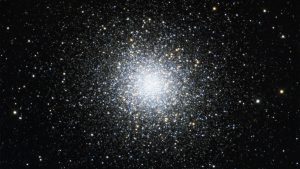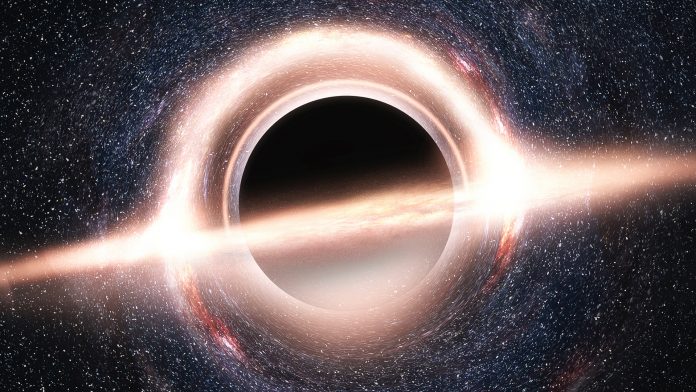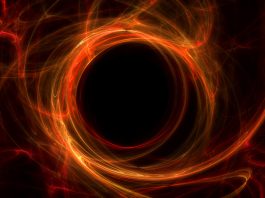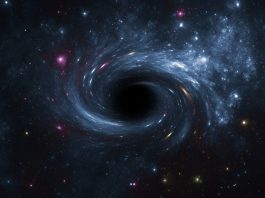An international group of astrophysicists and astronomers have identified that the Palomar 5 star cluster hosts an abnormally massive black hole population.
The research, led by researchers at the University of Barcelona, has signified two distinctive features of Palomar 5 that suggests it is home to a massive black hole population – in excess of one hundred – a remarkably substantial amount for a globular cluster, intriguing scientists to investigate why this could be.
This research is published in Nature Astronomy.
The peculiar Palomar 5 cluster
Discovered by Walter Baade in 1950, Palomar 5 is situated in the Serpens constellation – a distance of around 80,000 light-years – forming over ten billion years ago in the earliest phases of galaxy formation in the Universe. Palomar 5 is just one of nearly 150 globular clusters that orbit the Milky Way and is ten times less massive and five times more extended than an archetypal globular cluster in its final stages of dissolution.
Palomar 5 has two distinct characteristics that make it a unique globular cluster, which the scientists have hypothesised is due to the presence of a massive black hole population at its centre. Firstly, it is one of the “spongiest” in the Milky Way, with its stars only having an average distance of a few light-years between them, which is comparable to the distance from the Sun to the next brightest. Secondly, is it linked with a specular stellar current that spans more than 20 degrees in the sky.

Professor Mark Gieles, the lead author of the study from the Institute of Cosmos Sciences of the University of Barcelona (ICCUB), said: “The number of black holes is roughly three times larger than expected from the number of stars in the cluster, and it means that more than 20% of the total cluster mass is made up of black holes. They each have a mass of about 20 times the mass of the Sun, and they formed in supernova explosions at the end of the lives of massive stars when the cluster was still very young.”
Tidal streams are streams of stars that have been emitted from disrupting dwarf galaxies or star clusters, with around 30 of these thin streams identified in the Milky Way halo in recent years.
Gieles said: “We do not know how these streams form, but one idea is that they are disrupted star clusters. However, none of the recently discovered streams has a star cluster associated with them. Hence, we cannot be sure. So, to understand how these streams formed, we need to study one with a stellar system associated with it. Palomar 5 is the only case, making it a Rosetta Stone for understanding stream formation, and that is why we studied it in detail.”
Investigating the massive black hole population
For their investigation, the team simulated the orbits and evolution of each individual star from the formation of the cluster until the final dissolution, varying the initial properties of the cluster until a desirable match with observations of the stream and the cluster was distinguished. The scientists identified that Palomar 5 formed with a lower black hole fraction, with stars escaping more rapidly than black holes, meaning the black hole fraction steadily decreased. The black holes enhanced the cluster in gravitational slingshot interactions with stars, resulting in more stars escaping and the formation of the stream; in around one billion years from now, the cluster will be comprised of entirely black holes.
“This work has helped us understand that even though the fluffy Palomar 5 cluster has the brightest and longest tails of any cluster in the Milky Way, it is not unique. Instead, we believe that many similarly puffed up, black hole-dominated clusters have already disintegrated in the Milky Way tides to form the recently discovered thin stellar streams,” said co-author Dr Denis Erkal at the University of Surrey.
Gieles commented: “We have shown that the presence of a massive black hole population may have been common in all the clusters that formed the streams.”
This research provides unprecedented insights into the formation of globular clusters, enhancing our understanding of the initial masses of stars and their evolution, in addition to the consequences of gravitational waves.
“It is believed that a large fraction of binary black hole mergers form in star clusters. A big unknown in this scenario is how many black holes there are in clusters, which is hard to constrain observationally because we cannot see black holes. Our method gives us a way to learn how many black holes there are in a star cluster by looking at the stars they eject,” added Dr Fabio Antonini from Cardiff University, a co-author of the paper.









